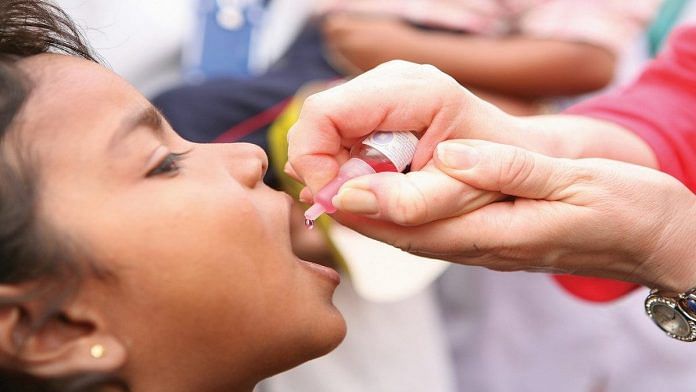Central govt is likely to issue advisory saying vaccine in question is ‘not harmful to children’.
New Delhi: The Central government has emphasised that there is no need to panic about reports that as many as 30 lakh children may have been administered oral polio vaccines tainted with an eradicated strain of the virus.
“There is no need to panic,” Preeti Sudan, secretary, the Ministry of Health and Family Welfare, told ThePrint, “Our surveillance and regulatory framework have done good work in identifying all possible threats.”
A senior bureaucrat handling immunisation programmes at the ministry said the government was likely to issue an advisory stating that “the vaccine in question was not harmful to children”.
Also read: Sewage worker deaths wouldn’t happen if India worked as hard on it as it did for polio
Even if it was administered to the children, the virus will be shed in the stool, the advisory will say, adding that an inactivated polio vaccine (IPV) booster shot may still be taken for precaution.
“If the child was administered the oral polio vaccine along with the IPV, there is no need to worry,” said the source.
“If the child was only administered the faulty oral polio vaccine, the virus will be shed in the stool. Additionally, the child can be given the IPV vaccine, which is an immunity boosting dose,” the source added.
The IPV is an injectable form of polio vaccine that can be administered alone or in combination with other vaccines like OPV (oral polio vaccine), or those for diphtheria, tetanus, pertussis, hepatitis B, and haemophilus influenza.
Although the oral polio vaccine is highly effective, easy to administer, and relatively inexpensive, its ability to generate a strong intestinal immunity to infection wanes as early as a year after vaccination, according to The Lancet.
An additional IPV dose substantially boosts levels of protective antibodies in the blood and intestinal immunity against polio virus.
IPV acts as a booster to minimise the risk of polio infection. It is already a part of India’s immunisation schedule and administered in four doses, between the ages of two months and six years.
India was officially declared polio-free by the World Health Organization (WHO) in March 2014. The last case of the wild polio virus type 2 in the country was in 1999.
Three years ago, India launched IPV as part of a ‘Global Polio Endgame’ strategy to prevent the re-emergence of polio.
The big scare
The statements came days after reports emerged that a tainted batch of oral polio vaccines manufactured by a Ghaziabad-based firm may have exposed children to a strain of the virus — type 2 — that has been eradicated around the world.
While initial reports traced the exposure to Telangana, Maharashtra and Uttar Pradesh, a health ministry officer said Maharashtra had been ruled out as an affected state.
“These faulty vaccines have reached only two states — Uttar Pradesh and Telangana,” said the officer.
However, Oommen C. Kurian, a fellow at thinktank Observer Research Foundation, said the immediate cause for worry was if the affected children included those born after April 2016.
That was the time the world declared type 2 eradicated and a shift was made from a ‘trivalent’ oral vaccine — which handles all three strains of the polio virus — to a ‘bivalent’ one. This means that children born after April 2016 and administered the oral polio vaccine are not immune to type 2, the strain in the affected batch.
“There is a rare chance that the weakened virus in the vaccine can regain strength and cause paralysis,” said Kurian. “The risk will be for kids who had just bivalent vaccine and not the IPV (which is trivalent).”
‘Blame poor regulatory control’
Kurian said the contamination spoke to poor regulatory control in India’s pharmaceutical sector.
“This is a direct result of the government’s lack of capacity to implement quality control,” he said.
“Public memory is short. But exactly the same thing had happened in 2016 itself, when a surveillance team of Telangana health authorities found the type 2 strain within Hyderabad city limits.
Also read: Before Modicare launch, over 33% children under 5 are stunted in these poll-bound states
“It was very clear that some manufacturers didn’t make the necessary shift from trivalent to bivalent (oral vaccines), or some dealers were selling old stock that was supposed to be destroyed,” he added.
“Obviously, the source couldn’t be traced then. Now, after two years, we hear Telangana’s name again. This could have been easily averted if the regulators did what they were supposed to do,” he said.
No data on affected kids
Meanwhile, the government is still unable to trace the children who may have been affected.
“There is no such data available. We have started the drive by alerting immunisation centres,” a health ministry source said.
“They have the list of children they had administered (the vaccine), but they might not know which vaccine was used on which baby,” the source added.







Is the health ministry playing with the life of innocents how don’t even know what for those drops were given to them instead of saving their life we are creating a hell for them what if they got paralysis